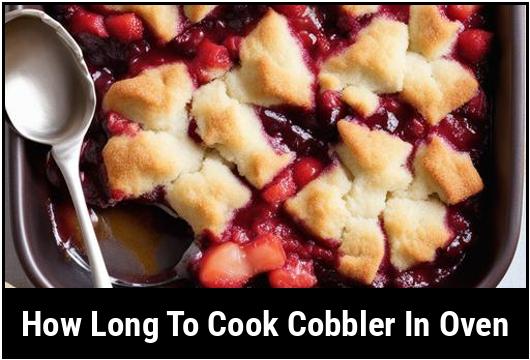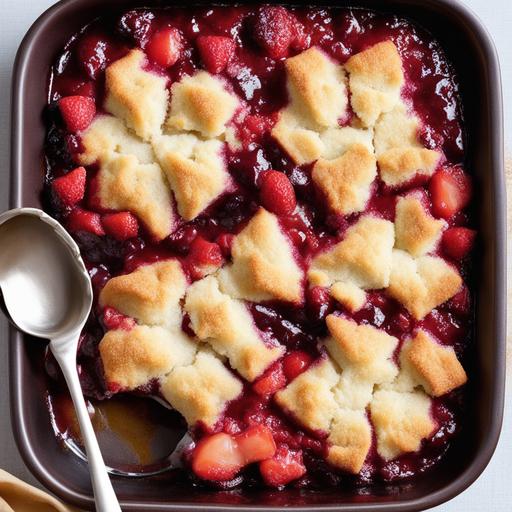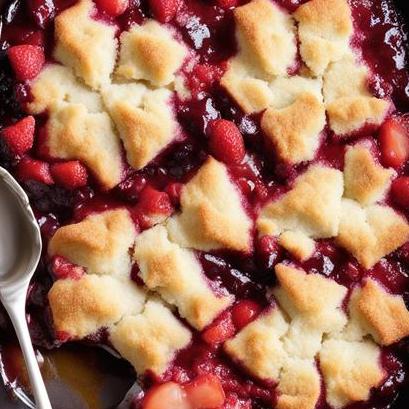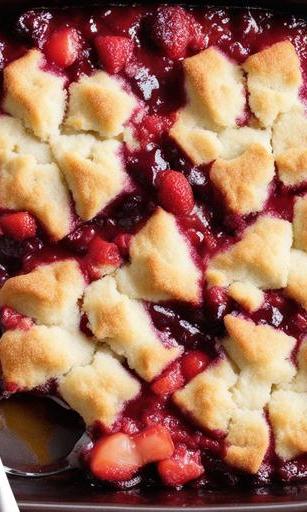[GUIDE] How Long To Cook Cobbler In Oven

Cobbler is a classic dessert that combines juicy fruit filling with a buttery, biscuit-like topping. It’s the perfect dessert for any season and can be enjoyed on its own or with a scoop of vanilla ice cream. One common question that arises when preparing cobbler is how long it should be cooked in the oven. In this article, we will explore the optimal cooking time for cobbler, as well as provide tips and techniques to ensure your cobbler turns out perfectly every time.
Quick Answer: How Long To Cook Cobbler In The Oven
The typical cooking time for cobbler in the oven is around 45 to 55 minutes. However, this can vary depending on various factors such as the type of fruit used, the thickness of the fruit layer, and the temperature of the oven. It’s important to monitor the cobbler closely during the baking process to ensure it is cooked to perfection.
Key Takeaways
- The average cooking time for cobbler in the oven is 45 to 55 minutes.
- Factors that can affect cooking time include the type of fruit used, the thickness of the fruit layer, and the oven temperature.
- It’s essential to monitor the cobbler closely during baking to avoid undercooking or overcooking.
- The cobbler is done when the filling is bubbly, and the topping is golden brown and cooked through.
The Science Of Cooking Cobbler

To understand the optimal cooking time for cobbler, it’s helpful to understand the science behind how it cooks. Cobbler consists of two main components: the fruit filling and the biscuit-like topping.
The fruit filling is typically made by mixing fruit with sugar, cornstarch, and sometimes spices. As the cobbler bakes in the oven, the sugar and cornstarch dissolve, thickening the juices released by the fruit. The heat from the oven causes the liquid to simmer and eventually bubble, creating a thick, bubbling fruit filling.
The topping, also known as the cobbler crust, is made with a basic biscuit dough. The dough is placed on top of the fruit filling and undergoes a transformation in the oven. The heat causes the butter in the dough to melt and create steam, which gives the cobbler crust a light and fluffy texture. The crust also turns golden brown due to the Maillard reaction, a chemical reaction that occurs between the proteins and sugars in the dough.
Choosing Cobbler
Before we delve into the cooking time, let’s briefly discuss the importance of choosing the right fruit for your cobbler. While most fruits can be used in cobbler, some work better than others. Here are a few things to consider when selecting fruit for your cobbler:
-
Freshness: Choose fruits that are ripe and flavorful. Avoid using overripe or underripe fruits, as they can affect the texture and taste of the cobbler.
-
Texture: Some fruits, like peaches and berries, work exceptionally well in cobbler due to their soft and juicy texture. Apples and pears can also be used but may require longer cooking times to soften.
-
Sweetness: Different fruits have varying levels of sweetness. It’s a good idea to taste the fruit before using it in your cobbler to determine if any additional sugar is needed.
-
Combining Fruits: Experiment with combining different fruits to create unique flavor combinations. For example, a peach and raspberry cobbler or a mixed berry cobbler can be delicious options.
Remember, the choice of fruit will not significantly impact the cooking time of the cobbler. However, it’s an important factor to consider when overall taste and texture are taken into account.
Preparing Cobbler
Now that we’ve chosen our fruit, let’s discuss the preparation steps before baking the cobbler. Proper preparation will ensure that the cobbler cooks evenly and has a delightful balance of flavors.
-
Washing and Cutting Fruit: For fruits like berries, it’s essential to gently wash them to remove any dirt or debris. For larger fruits, such as peaches or apples, peel and slice them into uniform pieces. This will allow the fruit to cook evenly and create a consistent texture in the cobbler.
-
Sweetening the Fruit: Most fruit fillings require some amount of sweetening. While some fruits may be naturally sweet enough, others may benefit from a sprinkle of sugar or a drizzle of honey. Adjust the sweetener according to your taste preferences and the sweetness of the fruit.
-
Thickening the Fruit Filling: To create a thick and luscious fruit filling, combine the fruit with a thickening agent such as cornstarch or tapioca flour. These ingredients will absorb excess liquid released by the fruit during baking and give your cobbler a velvety consistency.
Ideal Cooking Temperature For Cobbler
The ideal temperature for baking cobbler is between 375°F and 400°F (190°C – 200°C). This temperature range ensures that the fruit filling cooks thoroughly, and the cobbler crust becomes golden brown and crispy.
Cobbler Cooking Time

As mentioned earlier, the average cooking time for cobbler is 45 to 55 minutes. However, there are different factors that can affect the cooking time:
-
Type of Fruit: Different fruits have different levels of moisture and require varying cooking times. For example, berries are more delicate and juicy, while apples and pears may need additional time to soften.
-
Fruit Layer Thickness: The thickness of the fruit layer can impact the cooking time. Thicker layers will take longer to cook, while thinner layers will cook more quickly.
-
Oven Temperature: Variations in oven temperature can affect the overall cooking time. It’s essential to preheat your oven and ensure it maintains a steady temperature to avoid undercooking or overcooking the cobbler.
To determine if your cobbler is cooked through, look for the following signs:
-
Bubbling Filling: The fruit filling should be bubbly and thick. This indicates that the cornstarch or thickening agent has done its job, and the fruit is fully cooked.
-
Golden Brown Crust: The cobbler crust should be golden brown in color, indicating that it has cooked through. Use a toothpick or skewer to test if the dough is cooked inside.
-
No Doughy Taste: When you taste a small portion of the cobbler crust, it should not have a raw, doughy taste. This indicates that the cobbler has cooked sufficiently.
Cooking Techniques
To ensure that your cobbler cooks evenly and to the desired doneness, here are a few cooking techniques to consider:
-
Position in the Oven: Place the cobbler on the center rack of the oven. This will ensure even heat distribution and prevent the edges from overcooking.
-
Covering with Foil: If you notice that the cobbler crust is browning too quickly, you can cover it with aluminum foil. This will help prevent excessive browning while allowing the fruit filling to continue cooking.
-
Rotating the Pan: If your oven has hot spots, rotate the pan halfway through the cooking time. This will promote even cooking and prevent one side of the cobbler from overcooking.
Monitoring And Troubleshooting
During the cooking process, it’s essential to monitor the cobbler closely to avoid any mishaps. Here are some common issues that may arise and how to troubleshoot them:
-
Undercooked Filling: If the cobbler crust is golden brown, but the filling is still watery or undercooked, continue baking the cobbler for an additional 10 to 15 minutes. Check the cobbler periodically to ensure the crust doesn’t burn.
-
Overcooked Crust: If the filling is cooked, but the cobbler crust is overbrowned or burnt, you can tent the cobbler with aluminum foil to prevent further browning. This will help the filling continue to cook without risking the crust.
-
Uneven Cooking: If you notice that the cobbler is cooking unevenly, rotate the pan or move it to a different oven rack. This will ensure that all sides of the cobbler receive even heat.
Cobbler Cooking Instructions
Now that we understand the science, preparation steps, and cooking techniques, let’s dive into the step-by-step instructions for cooking cobbler:
-
Preheat the Oven: Start by preheating your oven to 375°F (190°C) or 400°F (200°C) depending on your recipe.
-
Prepare the Fruit Filling: Wash and cut the fruit as necessary. Combine the fruit with sweetener and a thickening agent such as cornstarch or tapioca flour. Toss well to ensure the fruit is evenly coated.
-
Transfer the Fruit Filling: Transfer the fruit filling to a baking dish or cast iron skillet. Ensure that the filling is spread evenly across the dish and has a consistent thickness.
-
Make the Cobbler Topping: Prepare the biscuit-like topping according to your preferred recipe. Drop spoonfuls of the dough on top of the fruit filling, allowing some space for the dough to expand during baking.
-
Bake the Cobbler: Place the baking dish in the preheated oven and bake for 45 to 55 minutes, or until the fruit filling is bubbly and the cobbler crust is golden brown.
-
Check for Doneness: Carefully remove the cobbler from the oven and check for doneness. Ensure that the filling is bubbling and the crust has a cooked-through texture. Allow the cobbler to cool for a few minutes before serving.
Variations

While the traditional cobbler recipe consists of fruit filling and a biscuit-like topping, there are numerous ways to personalize your cobbler. Here are a few variations to consider:
-
Streusel Topping: Instead of a biscuit-like topping, opt for a streusel topping made with butter, sugar, flour, and your choice of nuts or oats. This will add an extra layer of texture and flavor to your cobbler.
-
Cinnamon or Nutmeg: Add a sprinkle of cinnamon or nutmeg to your cobbler filling for a hint of warmth and spice.
-
Alcohol-infused Cobbler: Consider adding a splash of your favorite liqueur or spirit to the fruit filling to enhance the flavor profile. Just make sure to adjust the sugar content accordingly.
-
Savory Cobbler: For a unique twist, experiment with savory cobbler recipes. Swap the fruit filling for vegetables, meat, or poultry, and top it with biscuits or a cheesy crust.
When Things Go Wrong
Even with careful planning and preparation, things may not always go according to plan. If your cobbler doesn’t turn out as expected, here are a few common issues and possible solutions:
-
Soggy Bottom: If your cobbler has a soggy bottom, it may be due to excess liquid from the fruit filling. Next time, try reducing the amount of liquid released by the fruit or increasing the thickening agent to achieve a firm and crisp bottom crust.
-
Burnt Crust: If the cobbler crust is burnt while the filling is still undercooked, it may be due to high oven heat or placing the cobbler too close to the heat source. Lower the oven temperature slightly and move the cobbler to the center rack to prevent excessive browning.
-
Tough Crust: If the cobbler crust is tough or dense, it may be due to overmixing the dough or using too much flour. The dough should be gently mixed until just combined, allowing for a tender and flaky crust.
Serving Cobbler
Cobbler is best enjoyed warm, straight out of the oven. Serve it on its own or with a scoop of vanilla ice cream or a dollop of whipped cream for added indulgence. Cobbler can also be reheated in the oven or microwave if there are leftovers.
Best Practices For Cobbler Cooking
To ensure consistently delicious cobbler, here are some best practices to keep in mind:
-
Use Evenly Ripened Fruit: Select fruits that are evenly ripened for the best flavor and texture.
-
Uniform Fruit Thickness: Slice the fruit into uniform thickness to ensure even cooking.
-
Double-check Doneness: Always double-check the filling and crust for readiness before removing the cobbler from the oven.
-
Adjust Cooking Time: If needed, adjust the cooking time based on the specific fruit used and its cooking requirements.
Remember, practice makes perfect. The more you experiment with cobbler recipes and techniques, the better your cobbler will turn out.
Conclusion
Cooking cobbler in the oven requires careful attention to detail and a basic understanding of the science behind the baking process. By following the recommended cooking time range of 45 to 55 minutes, monitoring the cobbler closely during baking, and using the troubleshooting tips provided, you can achieve a perfectly cooked cobbler with a bubbling fruit filling and golden brown crust. Enjoy experimenting with different fruits, toppings, and variations to create your signature cobbler recipe that will delight your family and friends.
FAQS
What Temperature Should I Set My Oven To When Baking A Cobbler?
Preheat your oven to 375°F (190°C) before placing the cobbler into the oven.
How Long Should I Bake A Fruit Cobbler In The Oven?
Baking time for a fruit cobbler typically ranges between 40-50 minutes or until the fruit is bubbling and the topping is golden brown.
Can I Use A Glass Baking Dish To Make A Cobbler In The Oven?
Yes, you can use a glass baking dish to make a cobbler in the oven. However, make sure to reduce the oven temperature by 25°F (15°C) to avoid over-browning or burning the topping.
How Do I Know If My Cobbler Is Fully Cooked?
Use a toothpick or cake tester to check if the cobbler is fully cooked. Insert it into the center of the topping, and if it comes out clean, it is ready.
Should I Let My Cobbler Cool Before Serving?
Yes, you should let your cobbler cool for at least 10-15 minutes before serving it. This allows the filling to set and makes it easier to serve.
Sources
About the Author Jenny
I'm Jenny, a housewife with an unwavering passion for food. My culinary journey began with my grandmother's kitchen, and it's now a full-fledged food blog. I've turned my love for cooking into a creative outlet, sharing recipes and stories with a global community of fellow food enthusiasts. It's proof that being a housewife can also mean pursuing your passions and savoring life's delectable moments.
